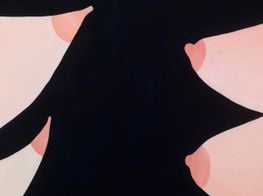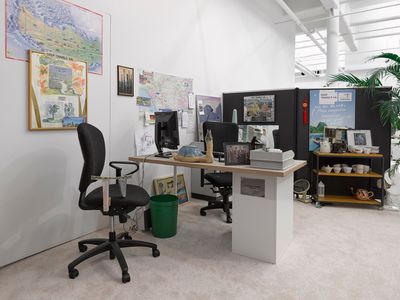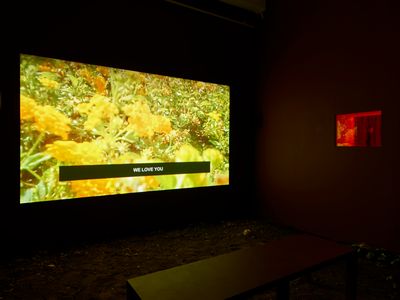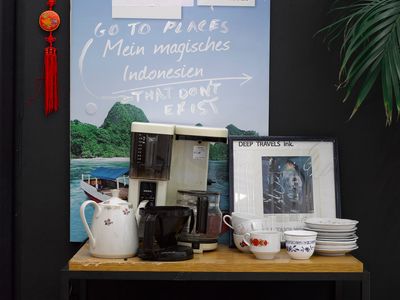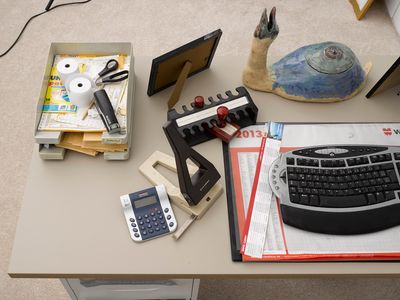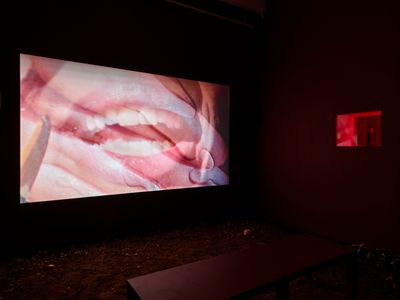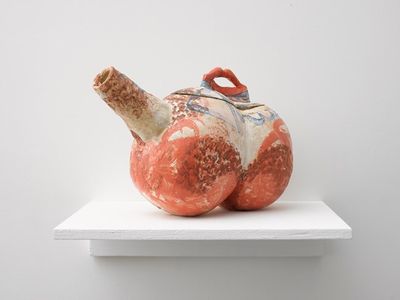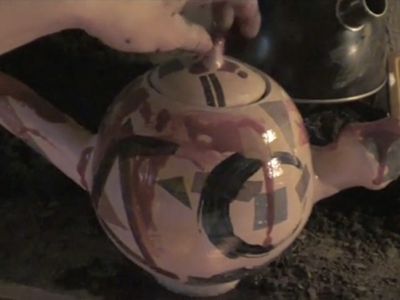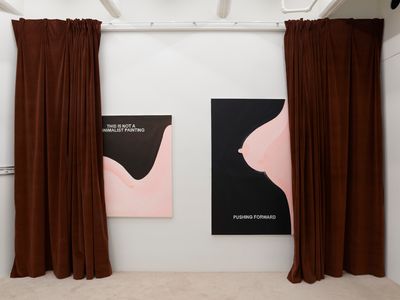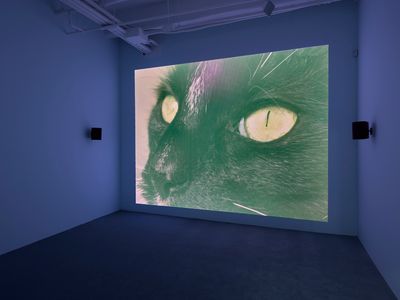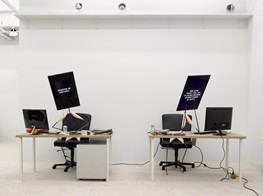Laure Prouvost
Laure Prouvost. Courtesy Lisson Gallery, London/New York. Photo: © Harry Kampianne

Laure Prouvost. Courtesy Lisson Gallery, London/New York. Photo: © Harry Kampianne
Laure Prouvost's most recent exhibition in New York at Lisson Gallery (9 March–14 April 2018) was a gesamtkunstwerk of sorts.
The show spread through the entire 10th Avenue gallery space and included two years of artistic production: installation, sculpture, painting, textile, sound and moving image. Uncle's Travel Agency Franchise, Deep Travel Ink. NYC (2016–2018) transplants us into a subterranean world. First produced for Museum für Moderne Kunst in Frankfurt am Main in 2016, the 'agency' takes over the entrance of the gallery, including the reception desk.
Like a period room, standing in it takes us back in time to the furnishings of the 1980s or 90s: smoky offices, analogue supplies; maps, calendars, and photographs from the modern world. Books line the shelves of the agency, and upon closer inspection, their titles clue us into what Prouvost is reading and thinking about within the framework of this project, and her ideas around art objects and artistic production.
Sir Richard Frances Burton's translation of The Arabian Nights encourages us to embrace a multiplicity of gazes and lenses. Perhaps Prouvost uses Burton as a character study of what deep and immersive exploration looks like.1 Everything Prouvost has laid out is meticulously placed. The more you dig, the more you find, but without knowing if it is to unravel anything. A kind of ouroboros, a snake eating its own tail; we might follow blindly, consuming whatever narrative is placed before us. The Ebony Tower (1974) by John Fowles is another title placed a few books down on the same shelf.
The narrative revolves around an elderly painter living in seclusion until his solitary life is taken over by another younger artist, commissioned to do a biographical study. Perhaps this is in reference to Prouvost's position in this and earlier works, such as the Turner Prize winning video, Wantee (2013), based on Prouvost's grandfather, a conceptual artist. Tropic of Cancer (1934) by Henry Miller is another title that points to the possibility that Prouvost has adopted a similar methodology to Miller in making her artworks, bringing together autobiography and fiction, stream of consciousness and revelations about the world in which we inhabit and devour.
Once past the façade of the travel agency, we enter into a world where flat screen monitor heads speak to you from wiry metal bodies. Sitting behind a cluttered desk, one balances its monitor head between its metal stick hands, uttering self-conscious phrase such as, 'I wish the work I was doing was deeper ... but I am just this monitor on sticks of metal'. A weird intimacy is set up between the artwork, an awkward looking machinic figure, and its viewer. This is perhaps not so far from our current predicament where we converse with virtual assistants with oddly gendered names like, 'Siri', 'Alexa', and 'Cortana' whom we may also imagine as having human attributes, a character, and opinions.
Prouvost imagines, in a rather absurd and humorous way, another kind of female future with We Will Feed You, Cooling Fountain (For Global Warming) (2018): a sculpture of a fountain made out of a bunch of blush-pink, blown-glass breasts with large red nipples—they look more like a bundle of buoys being drained of water—squirting streams that fall into a basin of goldfish happily swimming around two sunken smartphones.
Reflecting on what Prouvost describes as 'this apocalyptic glamour of condensed life' is the video installation Into All That Is Here (2015).2 A work dating a few years back, it depicts a frenzy of images. Beginning with the figure of a man descending into the ground, the sound of rustling of leaves accompanies Prouvost's voice narrating: 'Go further, deeper, to get closer to your desire'. At the end of the tunnel is a burst of flowers that kiss each other, and suddenly a new montage of images, this time violent footage from mass media, enters the frame only to end in a blaze.
In this conversation, Prouvost discusses straddling the realms of reality and fiction, linking previous and current works, collaborations, and losing oneself in the making and experiencing of art.
FKYour work deals with language, geography, and travel. Experiencing it means to be immersed and actively engaged in an environment where reality and fiction are constantly questioned. I'm not sure it matters whether what is being depicted is real or fictitious, because the viewer becomes so involved with the narrative's possibilities.
However, there still exist identifiers in the installations and video works that place us in different geographic locations: in a garden that has a specifically 'European' vegetation while making mention of a tunnel leading to Africa, the voice over is in English with a French accent, there is the travel agency, so there is some sort of triad of travel, settle and lived experience. They connote very particular social, political or personal histories. Could you tell me more about how you work with this material while navigating between the 'real' and the fictional?
LPI was thinking yesterday about whether or not fiction is an answer to reality. It kind of enhances reality or through art, this kind of emotional reality. It makes you question your own reality, so that your reality becomes fictional. It makes reality slightly more exciting and layers it.
It's kind of a big question. It gives me the freedom to say things I wouldn't dare say if it were true. In a conversation, I see you—there's much more of a connection and more complexity as we are talking now. All our senses are activated. When I make an artwork, it's more abstract, less complex—it keeps things open with a simple subject. Wherever you come from, whatever your history, the art work travels in this agency. We're not sure when it was made: it's post-apocalyptic, it looks like it belongs in the eighties—the boundaries of time are less clear.
At the same time, I use this seventies, eighties, or nineties aesthetic with these weird metal men and monitors produced today. All these layers makes it, I hope, open for everyone. I don't want to give one basic story. There are many narratives within one show and many points of view for whoever experiences it or gives it energy. It's really an exchange—whoever wants to give it energy, whoever wants to enter that world, hopefully will carry it on outside its own space.
FKUncle's Travel Agency Franchise, Deep Travel Ink. NYC was produced in 2015 and reproduced again at Lisson Gallery in New York, right?
LPIt's just the front part that was produced in Frankfurt in 2015, and I always imagined that it could grow. I see it also as a franchise—Uncle is so happy that he is invited to New York where he can expand his franchise—or where the fiction can grow somewhere else. It has that idea of a shop window, and when Lisson asked me to do a show there, it was perfect with that window looking straight onto the street.
It also questioned art and what we believe a show can be. It was the right place to develop it, I saw the back much more as an office space with metal people, totally useless and repetitive, pretending to work. They work for the imagination, basically. They work to take you to a place without you having to go or move. So, it's a very simple concept. And then there is the video that you can escape or enter.
FKLet's talk about the monitors. After viewers pass through this amazing period room that resembles an eighties tourism agency, they're transported to a surreal space containing flat screen monitors, indoor plants, a fountain, and metal stick figures. The first monitor greets viewers with the phrase: 'Hello and welcome to deep travel ink'. It's funny, I stood there, and I watched the whole video and read all the subtitles, while people passed by and I was always in the way. That moment is like an instruction to navigate the space. It is also an invitation to hunt for the hidden elements within the works on view, but the subtitles also point out the various objects, such as a map (Tourist Map, Deep Travel Ink., 2018) on the wall behind the viewer.
We're also lead to believe that 'if you come with us' you will encounter an octopus who will show the way and be fed from big breasts, and as we turn to continue, we have to sidle past a fountain of large breasts hanging like a bunch of grapes from which water trickles into a pool of unknowing, swimming goldfish. It's quite absurd and purposefully theatrical, which is something that has been ongoing in your practice. Can you talk about the format but also the work demanding something of its viewer?
LPYou described it so much better than I ever will! I think there are so many exchanges and that's where art is wonderful. I articulate through the art work and together we articulate it differently. It's great! Often, I work with the space I'm being given. I'm thinking of how to use the space, and if possible, create different connections in the brain as a show. It's like you have a path and whichever path you take may lead you in one direction or another. The front looks like the façade of some normal travel agency. And then you read a text and suddenly you end up somewhere so far from the initial reading.
When I started working as an artist I would work around film and video and focused just on the videos. Buy there's always this question of losing oneself in the complexity of the world but also the complexity of video editing, which is where I definitely create an escape and an environment through video. And then it grew into physicality in my practice. I really enjoyed the idea of the viewer becoming part of the work. It's kind of simple, but childish as well. The phrase, 'You're on the chair where grandma sat' kind of plays a game with the object that is there, and the path is much more obvious than my video work, but it's to really embrace the body, I guess. The mind is there, it's being used for the films.
I want the body to have as much power as the brain, almost, in its interaction with life and work. It's really about being conscious of where you are and how you're being manipulated but also exchanging ideas with the situation and being part of this system. It really grew from the narrative of the film and that contains three-dimensional elements, it's not just pixels. You're walking on the carpet, and now, you are that carpet because you're walking on it. You connect to everything, including the horrible smell of that carpet. I used to make much simpler shows ...
FKSomething that struck me was that as soon as I forgot myself, I also remembered where I was. The works are conscious of their materiality but also what they might be doing, conceptually.
LPIt's fiction but it's also positioning you as a viewer. Especially with the video work, which says, 'Ok, we're going on a trip'—it's important to have this awareness. It's much more about playing together.
You bring text and image into play with sound. The video installation, Into All That Is Here (2015) is an absorbing work that was also shown in a solo exhibition of the same name at Red Brick Art Museum in China back when you first made it (28 May–28 August 2016). The work is packed with rich images, it can be quite overwhelming, yet very seductive. It's playful and childish, but then there's also this bizarreness that has you second guessing. I was wondering if you could talk a little bit about how the work seeks to totally absorb viewers? You are really capable of creating an environment where all the senses are heightened.
I think that is definitely something I strive to do. It doesn't always come alive or work. I think it's similar to how poetry can trigger memory and enhance sensations. In the film I was playing on sexuality, but also very much on the imagined experience of being an insect, springtime, desire, ecstasy, the ecstasy of the world. Looking at society at the moment, we drink and eat and constantly want as much as possible.
This crazy situation where humanity has arrived. And also, how we are bombarded with things constantly—images from society but also through artists' work. This is enhanced in the film but at the same time it hopefully brings that ecstasy through in a complex way: it's smell, it's touch, but it's also the death of it—it's so fast, and the image and the work is melting. It wants so much to be alive, it wants so much attention. That video for me was very much about the consumption of everything, and sexuality can come into it too, people can see it that way.
It's childish in that way, almost, but at the same time it's this drive of humanity and how humans reproduce and grow and reproduce and grow but die as well. It is animalistic and also complex. It's a very layered piece for me but it's also simple and smelly. I strive for this, when I make a video, I love when someone says, 'Oh your film stinks'. It can be something else, other than pixels. I strive for that. It's not always easy.
FKThe characters in the works include your uncle and grandparents as well as others. They help you communicate ideas in the artwork. These figures, characters, and voices that appear in your videos and installations fragment authorship in the way in which they begin to operate almost like references to the language of society. Meanwhile, they are also family members, which we can relate to. Could you discuss how you reconcile these elements that are both real and fictional, familiar and strange, and sometimes even taboo or embarrassing?
LPMy decision to start working with characters happened so quickly. I borrow these characters from life and from my family. We all have grandparents, dead or alive—we all come from a history. I'm talking about history and ancestors, where we come from, and where art comes from and where it is going. Female artists nowadays are so magical—we have a whole history to grow on and develop. These characters are really a personal link to the bigger picture—to feminism and humanity. The uncle is a little bit more removed.
The great thing for me with fiction is that I'm less precious about what I say. It's not me. It's not my point of view. As I use words so much, it's nice to have another character who says things that feel so wrong. Like, when I see my family who say, 'Oh I don't get contemporary art', and then to place these narratives into the work for me is important—to break a little bit of elitism and bring humour in why we make contemporary art.
Of course, we want to bring up important ideas or question the way humans work. But through these characters, there are so many layers. I can get the grandma to repair the chairs [in Wantee] with Kurt Schwitters, because my grandma doesn't care about Kurt Schwitters. She's just his friend and she's got too many sculptures, it's sort of through the narrative that there are so many opportunities to expand ways of seeing the world. It is also quite practical. What is art for? That's the main question—is art practical, is art useful? That's the question that constantly enters society ... it's meant to provoke the brain. It's a kind of luxury to be able to reflect on our own lives and these characters give me this freedom, I think, to enter this point of view.
I'm questioning the idea of narration and how you tell the story, the way you tell it. So, from the beginning, I had first found some pictures at a flea market of a couple and then I recreated their whole narrative around it, and then mistranslated to French again with the subtitles. So, you have this whole possible narrative from just a set of pictures, and how language enters and how words give powerful meanings to images. I was also a student of John Smith, and we could provoke each other a little bit around this idea of telling stories. I don't really know because I'm naturally not good at writing, that's not where it comes from, it's much more around imagination.
FKYou question history and the forms and ruminating narratives of the language that produces it. For example, in Wantee Kurt Schwitters is mentioned and the viewer is meant to understand that he was a friend of your grandfather who also was a conceptual artist.
How about the female character who makes and serves tea, the lips sculpted into teacups, tea bubbling from the teapots, and so on. It appears quite abject. Can we talk about women and history? How do close-ups of sizzling meat, a hot knife cutting through bubbling butter, sweaty women working out, and sexualised female lips speak to the effects of portrayals of history?
LPHistory is definitely constantly moving. What is history? History you read in a book is very much the history of a nation, or the result of someone's decision as to what is important. Art history points towards artworks that were created at a certain time, and then there's the personal history and where we come from and that history is written about less or has less power purely, maybe, because it hasn't been written about.
I often question the authority of the written text. As soon as it's written there's an authority in the fact that we should read and know about it, but history is always changing. I mean the history of art. It's in constant flux and I guess that's how it comes through in my work. As soon as the artist is dead, society owns the work. There is the idea that the art work is so nervous to be kept and not to be forgotten in storage—it still wants to be relevant. So, it's a history of the relevance of the object, and that's in constant flux.
I used to insist on [John] Latham. This artist was very important for me. He was always about intense structure; organising the thinking around the organisation of society; and how everything of course has its identity from its time but at the same time it's kind of interesting to think about how the timeline would be very different and things would just appear. I don't know, it's almost impossible to be in a different time zone mentally, and history has that as well I guess because it's how it's remembered and how it changes.
My grandma wrote text on a painting she found in the back of my grandad's studio. It suddenly became her work. She says it's to improve it, and she keeps adding stuff to the studio to make it more interesting for the visitors. That's the side that I'm interested in. I like the work that is in constant flux.
FKI am picturing the breasts and text The Hidden Paintings Grandma Improved – We Are Coming Out (2017). Is that the painting you're referring to?
LPShe found these paintings behind a big wall that my grandad had built and now she's improving them with text. I mean he had done the boobs. It's also that history of the female artist. It's her time. Grandad is from a different time zone, and it's kind of her time, also my time. It's a very basic painting, straight in your face. But it's fun to play with that now—it's a new history, and we're going to push it further. And of course, it's a little provoking. I think the female body has entered a lot more in my recent work, for sure.
FKCould you tell me a bit about your show at the Walker Art Center that just closed in February of this year?
LPAt the Walker, I showed a video called DIT LEARN (2017). It's about un-learning but also re-learning. I have two young children, of course they're a part of my life, and I was really looking at almost trying to connect to them in that pureness of language connection. I'm not trying to become a useless baby, it's more about re-experiencing that moment of pure connection to what's there without words. So, it's a film, which I constructed in four parts. One, was you learn stuff. So, it's about 'this means that'. This apple means 'anger', or means 'come here'. So, the object starts telling you new meanings, and you're learning this as an audience and through signs of objects. And then you have to use them. We produce things with them, or we exchange ideas and we have to be active, then it is just words purely as they are.
I remember when they were one year old saying things like, 'Look mama, tree, tree'. One section is just purely, simply word to an object and the connection of the brain to that thing. And then at the end as the fourth part there are no more words, you are everything; you are the apple, you are the table, you know the taste of that wooden table, you are the taste of it, you are the physicality of it, and I don't know if it is a child or an animal. So that was really my structure of how I was trying to make the film. We showed the film in a kind of long corridor, and there was a waiting room, and I was also playing on masculine and feminine. In French we have a system where the word 'sea' is feminine, but 'wall' is masculine.
Latin speakers make mistakes when using this system, but then it also kind of creates an object's physicality, it makes it more human. I'm interested in that. We feminised a lot of objects in the gallery with boobs and things that grow out of places that are considered feminine. And then you watch a film and you escape, and then there's a room where you just look outside and connect to everything. That was the piece I produced for the show. I think it's getting somewhere!
FKIt's really interesting to hear you talk about it. When my son was a baby, I discovered that I was getting another chance to experience those things all over again, just by trying to observe how my son was connecting to the world around him.
LPI think a lot of people are unsure when talking about children or family. It's not so much about talking about it, but about a way of connecting to the world. It's interesting because there's a prudeness when it comes to touching on this subject in the system we are in.
FKAnd how are things progressing for your upcoming exhibition, Ring, Sing and Drink for Trespassing at Palais de Tokyo (22 June–9 September 2018)?
LPThere is a lot of new work that I still don't know about. We are working on a sort of abandoned garden. It's a lot about what we talked about, the history of art. There will be two huge tapestries, a kind of derelict place that will contain a lot of hidden things, and I'm making a new film in a garden in a shed, and there will be a fountain with goldfish inside. I don't want to say too much. It's hard to talk about it now ... it's about global warming in some ways. —[O]
1 Burton was a British explorer, translator, orientalist, and cartographer who is also historicised as a character who was critical of the colonial policies of the British Empire and becoming famous for his explorations of Asia, the Americas and Africa.
2 See artist's website for full statement: http://www.laureprouvost.com/menu.html

